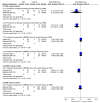Management of Tooth Extraction in Patients Taking Antiresorptive Drugs: An Evidence Mapping Review and Meta-Analysis
- PMID: 36615038
- PMCID: PMC9821631
- DOI: 10.3390/jcm12010239
Management of Tooth Extraction in Patients Taking Antiresorptive Drugs: An Evidence Mapping Review and Meta-Analysis
Abstract
Background: Medication-related osteonecrosis of the jaw (MRONJ) is a well-known severe adverse reaction of antiresorptive, antiangiogenic or targeted therapies, and usually occurs after tooth extraction. This review is aimed at determining the efficacy of any intervention of tooth extraction to reduce the risk of MRONJ in patients taking antiresorptive drugs, and present the distribution of evidence in these clinical questions.
Methods: Primary studies and reviews were searched from nine databases (Medline, EMBase, Cochrane Library, Scopus, WOSCC, Inspec, KCI-KJD, SciELO and GIM) and two registers (ICTRP and ClinicalTrials.gov) to 30 November 2022. The risk of bias was assessed with the ROBIS tool in reviews, and the RoB 2 tool and ROBINS-I tool in primary studies. Data were extracted and then a meta-analysis was undertaken between primary studies where appropriate.
Results: Fifteen primary studies and five reviews were included in this evidence mapping. One review was at low risk of bias, and one randomized controlled trial was at moderate risk, while the other eighteen studies were at high, serious or critical risk. Results of syntheses: (1) there was no significant risk difference found between drug holiday and drug continuation except for a subgroup in which drug continuation was supported in the reduced incidence proportion of MRONJ for over a 3-month follow-up; (2) the efficacy of the application of autologous platelet concentrates in tooth extraction was uncertain; (3) there was no significant difference found between different surgical techniques in any subgroup analysis; and (4) the risk difference with antibacterial prophylaxis versus control was -0.57, 95% CI -0.85 to -0.29.
Conclusions: There is limited evidence to demonstrate that a drug holiday is unnecessary (and may in fact be potentially harmful) in dental practice. Primary closure and antibacterial prophylaxis are recommended despite limited evidences. All evidence have been graded as either of a low or very low quality, and thus further high-quality randomized controlled trials are needed to answer this clinical question.
Keywords: evidence mapping; medication-related osteonecrosis of the jaw; meta-analysis; preventive dentistry; tooth extraction.
Conflict of interest statement
The authors declare that they have no conflict of interest. The funders had no role in the design of the study; in the collection, analyses, or interpretation of data; in the writing of the manuscript; or in the decision to publish the results.
Figures






Similar articles
-
Efficacy of a high-dose antiresorptive drug holiday to reduce the risk of medication-related osteonecrosis of the jaw (MRONJ): A systematic review.Heliyon. 2020 Apr 27;6(4):e03795. doi: 10.1016/j.heliyon.2020.e03795. eCollection 2020 Apr. Heliyon. 2020. PMID: 32373730 Free PMC article. Review.
-
The Effect of Antiresorptive Drug Holidays on Medication-Related Osteonecrosis of the Jaw: A Systematic Review and Meta-Analysis.Cureus. 2022 Oct 19;14(10):e30485. doi: 10.7759/cureus.30485. eCollection 2022 Oct. Cureus. 2022. PMID: 36415385 Free PMC article. Review.
-
Tooth extractions in patients with cancer receiving high-dose antiresorptive medication: a randomized clinical feasibility trial of drug holiday versus drug continuation.Oral Surg Oral Med Oral Pathol Oral Radiol. 2022 Feb;133(2):165-173. doi: 10.1016/j.oooo.2021.06.003. Epub 2021 Jun 10. Oral Surg Oral Med Oral Pathol Oral Radiol. 2022. PMID: 34275774 Clinical Trial.
-
Risk-reductive dental strategies for medication related osteonecrosis of the jaw among cancer patients: A systematic review with meta-analyses.Oral Oncol. 2018 Oct;85:15-23. doi: 10.1016/j.oraloncology.2018.08.003. Epub 2018 Aug 14. Oral Oncol. 2018. PMID: 30220314
-
Medication-related osteonecrosis of the jaw: risk factors in patients under biphosphonate versus patients under antiresorptive-antiangiogenic drugs.Minerva Stomatol. 2017 Aug;66(4):135-140. doi: 10.23736/S0026-4970.17.04056-0. Epub 2017 May 10. Minerva Stomatol. 2017. PMID: 28497661
Cited by
-
Enhancing the Oral Rehabilitation and Quality of Life of Bisphosphonate-Treated Patients: The Role of Dental Implants.Cureus. 2023 Oct 7;15(10):e46654. doi: 10.7759/cureus.46654. eCollection 2023 Oct. Cureus. 2023. PMID: 37942370 Free PMC article. Review.
-
Comparison of Different Antibiotic Regimes for Preventive Tooth Extractions in Patients with Antiresorptive Intake-A Retrospective Cohort Study.Antibiotics (Basel). 2023 Jun 1;12(6):997. doi: 10.3390/antibiotics12060997. Antibiotics (Basel). 2023. PMID: 37370316 Free PMC article.
-
Prognosis of intentional replantation for periapical periodontitis teeth: a systematic review and meta-analysis.BMC Oral Health. 2025 Jul 26;25(1):1258. doi: 10.1186/s12903-025-06583-1. BMC Oral Health. 2025. PMID: 40713650 Free PMC article.
-
Reduction of MRONJ risk after exodontia by virtue of ozone infiltration: A randomized clinical trial.Oral Dis. 2024 Nov;30(8):5183-5194. doi: 10.1111/odi.15006. Epub 2024 May 29. Oral Dis. 2024. PMID: 38807567 Free PMC article. Clinical Trial.
-
Three-dimensional clinical assessment for MRONJ risk in oncologic patients following tooth extractions.Dentomaxillofac Radiol. 2023 Nov;52(8):20230238. doi: 10.1259/dmfr.20230238. Epub 2023 Oct 24. Dentomaxillofac Radiol. 2023. PMID: 37874081 Free PMC article.
References
-
- Ruggiero S.L., Dodson T.B., Aghaloo T., Carlson E.R., Ward B.B., Kademani D. American Association of Oral and Maxillofacial Surgeons’ Position Paper on Medication-Related Osteonecrosis of the Jaws-2022 Update. J. Oral Maxillofac. Surg. 2022;80:920–943. doi: 10.1016/j.joms.2022.02.008. - DOI - PubMed
-
- Ruggiero S.L., Dodson T.B., Assael L.A., Landesberg R., Marx R.E., Mehrotra B. American Association of Oral and Maxillofacial Surgeons position paper on bisphosphonate-related osteonecrosis of the jaws—2009 update. J. Oral Maxillofac. Surg. 2009;67((Suppl. S5)):2–12. - PubMed
-
- Nicolatou-Galitis O., MASCC Bone Study Group. Kouri M., Papadopoulou E., Vardas E., Galiti D., Epstein J.B., Elad S., Campisi G., Tsoukalas N., et al. Osteonecrosis of the jaw related to non-antiresorptive medications: A systematic review. Support Care Cancer. 2019;27:383–394. doi: 10.1007/s00520-018-4501-x. - DOI - PubMed
Publication types
Grants and funding
LinkOut - more resources
Full Text Sources

